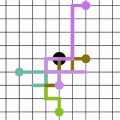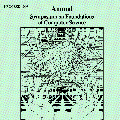Szegedy developed a generic method for quantizing classical algorithms based on random walks [Proceedings of FOCS, 2004, pp. 32-41]. A major contribution of his work was the construction of a walk unitary for any reversible random walk. Such unitary posses two crucial properties: its eigenvector with eigenphase $0$ is a quantum sample of the limiting distribution of the random walk and its eigenphase gap is quadratically larger than the spectral gap of the random walk. It was an open question if it is possible to generalize Szegedy's quantization method for stochastic maps to quantum maps. We answer this in the affirmative by presenting an explicit construction of a Szegedy walk unitary for detailed balanced Lindbladians -- generators of quantum Markov semigroups -- and detailed balanced quantum channels. We prove that our Szegedy walk unitary has a purification of the fixed point of the Lindbladian as eigenvector with eigenphase $0$ and that its eigenphase gap is quadratically larger than the spectral gap of the Lindbladian. To construct the walk unitary we leverage a canonical form for detailed balanced Lindbladians showing that they are structurally related to Davies generators. We also explain how the quantization method for Lindbladians can be applied to quantum channels. We give an efficient quantum algorithm for quantizing Davies generators that describe many important open-system dynamics, for instance, the relaxation of a quantum system coupled to a bath. Our algorithm extends known techniques for simulating quantum systems on a quantum computer.
翻译:Szegedy开发了一个基于随机行走的经典算法的量化通用方法[FOCS的进度,2004年,第32-41页]。他的主要工作贡献之一是为任何可逆随机行走建造一个单行单行。这种单行占有两个关键属性:其带有egenzy $0 的树皮基因变异器是随机行走分布限制和脑电流差异的量子样本,比随机行走的光谱差距大四倍。如果能够将Szegedy用于随机行走的地图上的随机动态地图的剖析法普遍化,这是一个有待解决的问题。我们对此的回答是肯定的,为详细的平衡的林德布拉德(Lindbov 半组的生成者)和详细的量子通道设计一个明确的单行行行单行单行单行单行单行道。我们证实,Lindblad行行行走的固定点可以作为egencreadculation的直径数, 并且其正位结构结构的平比我们所知道的正正正的平式变速度变的轨道要大。



